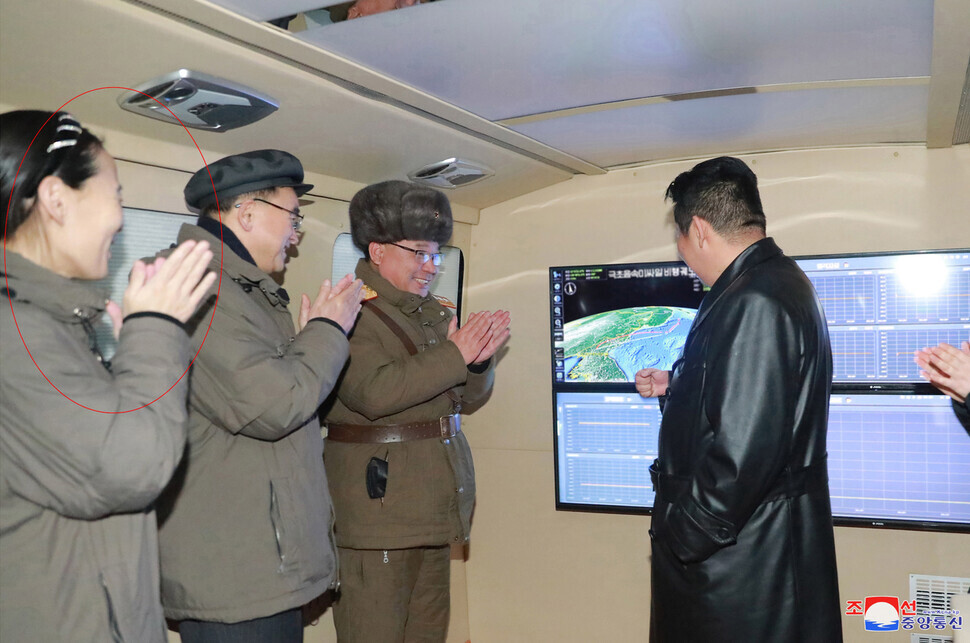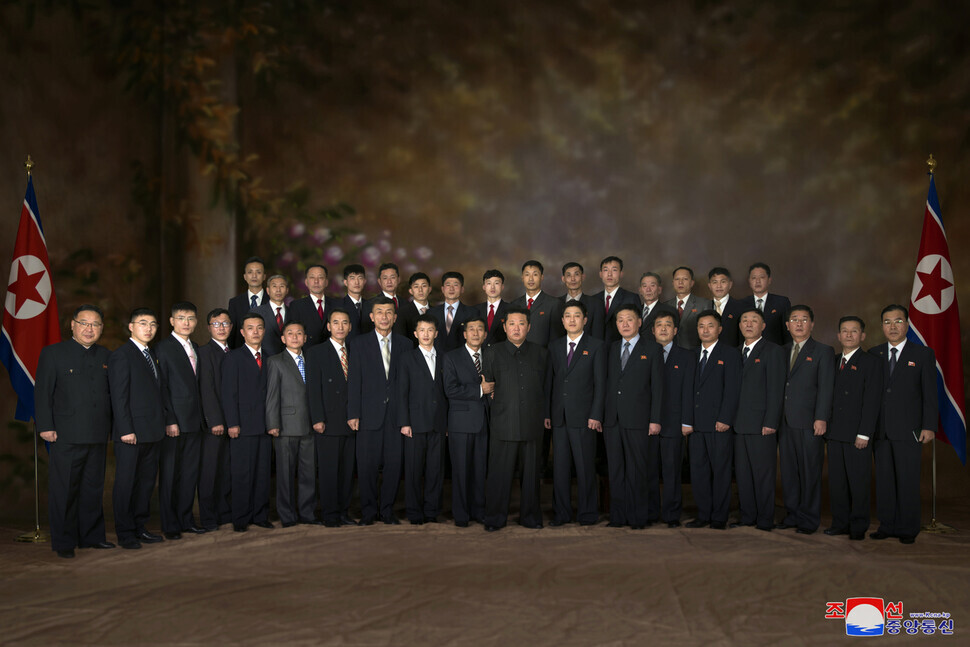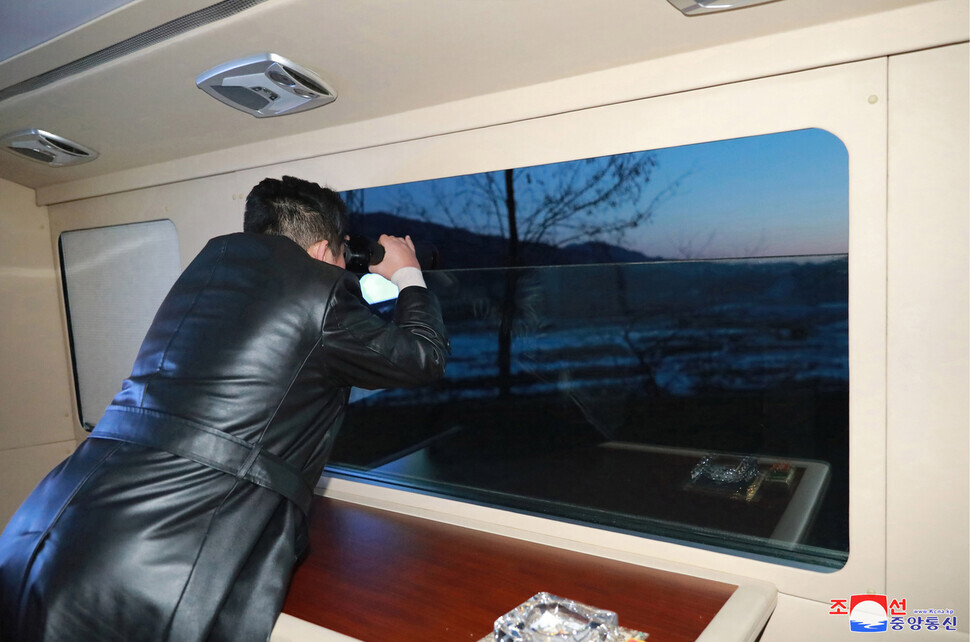hankyoreh
Links to other country sites 다른 나라 사이트 링크
[News analysis] Why Kim Jong-un attended missile test after nearly 2 years of absence

North Korean leader Kim Jong-un “watched the test-fire of [a] hypersonic missile conducted by the Academy of Defence Science on Tuesday,” with the “hypersonic glide vehicle” described as “hitting the set target in waters 1,000 km away,” the Rodong Sinmun newspaper reported in a front-page story Wednesday.
It was the first time Kim had observed a missile test on the ground in the 22 months since a “tactical guided weapon” test on March 21, 2020. The weapon tested then was a short-range ballistic missile that has been described as a “North Korean version of ATACMS” — a type of surface-to-surface missile.
Kim did not appear at the launch of a “new type submarine-launched ballistic missile (SLBM)” on Oct. 19 of last year.
On March 26, 2021, the Rodong Sinmun left its report on the test of “newly developed new-type tactical guided missiles” on page two, while giving front-page coverage to reports on Kim clarifying his “plan to newly erect the area of riverside terraced houses around [Pyongyang’s] Pothong Gate” and learning about “trial products of new passenger buses.”
![North Korean leader Kim Jong-un “watched the test-fire of [a] hypersonic missile conducted by the Academy of Defence Science on Tuesday,” with the “hypersonic glide vehicle” described as “hitting the set target in waters 1 000 km away,” the Rodong Sinmun newspaper reported in a front-page story Wednesday. (KCNA/Yonhap News)](https://flexible.img.hani.co.kr/flexible/normal/970/646/imgdb/original/2022/0113/9616420623951021.jpg)
With Kim having spent nearly the last two years emphasizing his focus on prioritizing the livelihoods of North Koreans and the economy without attending weapon launches in person, the fact that he took a private train all the way to Jagang Province (also spelled Chagang) to observe the “final test-fire” of a hypersonic missile can be seen as a significant change — one that should be considered in terms of its ramifications for military technology, domestic politics and foreign policy.
To begin with, it can be seen as a continuation of his practice of generally being present at the scene when the development of a new weapon is complete.
After previous tests on Sept. 28 and Jan. 5, the Rodong Sinmun described the latest hypersonic missile test as a “final test-fire.” The last time that Kim observed a launch in person, on March 21, 2020, it was also referred to as a “test-fire” ahead of its delivery of the “tactical guided missile” to People’s Army units.
But Kim’s attendance cannot solely be interpreted in terms of its significance in regard to the North’s military technology developments. A more important element appears to be the signals he sought to send both domestically and internationally.

The Rodong Sinmun article included no direct references naming South Korea or the US. But it did report Kim as stressing the need to increase North Korea’s “war deterrent” by “steadily build[ing] up the country's strategic military muscle both in quality and quantity.”
This was a continuation of rhetoric present in his remarks at the fourth plenary meeting of the Workers’ Party of Korea (WPK) Central Committee on Dec. 27–31, 2021, where he stressed, “The military environment of the Korean peninsula and the trend of the international situation getting instable day after day demand that bolstering the state defence capability be further powerfully propelled without a moment's delay.”
It also recalls the way the Rodong Sinmun’s report on the plenary meeting outcome mentioned that it had “set forth principled issues and a series of tactical orientation, all of which should be maintained by the sectors of the north-south relations and external affairs to cope with the rapidly changing international political situation and the circumstances in the surroundings,” but did not share any concrete directions for policies toward South Korea or the US.
It’s a notable aspect, as silence itself can be a crucial signal to the rest of the world.
The South Korean government appeared to pick up on the signal to Seoul and Washington from what was not said about Kim’s first visit to the scene of a missile test launch in 661 days.
Significantly, the Blue House made the unusual move of sharing separate remarks by President Moon Jae-in on Tuesday, the same day the North’s missile test was confirmed.

A Blue House spokesperson reported that the National Security Council standing committee had expressed “extreme regret” and called for the North’s “swift agreement to dialogue and cooperation.” The spokesperson also quoted the Joint Chiefs of Staff, describing the launch as a “violation of UN Security Council resolutions” and demanding an “immediate halt” to any plans for further launches.
At the same time, Moon was also quoted by the spokesperson as having expressed “concerns about North Korea conducting ongoing test launches ahead of the presidential election [in South Korea].”
The response read as reflecting the conclusion that with intelligence assets confirming Kim’s presence at the launch, the situation called for Moon to personally urge restraint from the North Korean leader. This latest development shows how high tensions are on the Korean Peninsula ahead of the Winter Olympics in Beijing next month and the South Korean presidential election on March 9.
First and foremost, Kim’s presence at the launch appeared to be meant largely for internal purposes — using a military achievement to unite the public amid its struggles with the long-term effects of sanctions, the COVID-19 pandemic and economic woes.
The Rodong Sinmun described the so-called hypersonic missile as “representing the power of the DPRK,” while praising the successful test as a “distinguished feat of WPK in history of leading Juche-based defence industry success.”
The article was accompanied by large photo inserts, mentioning that Kim had “called the core members in the sector of hypersonic weapon research and development to the office building of the Party Central Committee and warmly congratulated them.” It added that he had “a photo session with them” — strongly suggesting the report was meant for domestic propaganda purposes.
Also significant is the fact that the photographs showed not only Kim observing the launch, but also Jo Yong-won and Kim Yo-jong with him. Jo, the secretary for organizational affairs for the WPK Central Committee, has been described as Kim’s “shadow,” while Kim Yo-jong is the deputy director of the Central Committee’s Propaganda and Agitation Department.
Kim and Jo were also present the last time Kim Jong-un observed a missile test launch on March 21, 2020 — an indication of the extensive scope of their duties.
By Lee Je-hun, senior staff writer
Please direct questions or comments to [english@hani.co.kr]

Editorial・opinion
![[Column] Has Korea, too, crossed the Rubicon on China? [Column] Has Korea, too, crossed the Rubicon on China?](https://flexible.img.hani.co.kr/flexible/normal/500/300/imgdb/original/2024/0419/9317135153409185.jpg) [Column] Has Korea, too, crossed the Rubicon on China?
[Column] Has Korea, too, crossed the Rubicon on China?![[Correspondent’s column] In Japan’s alliance with US, echoes of its past alliances with UK [Correspondent’s column] In Japan’s alliance with US, echoes of its past alliances with UK](https://flexible.img.hani.co.kr/flexible/normal/500/300/imgdb/original/2024/0419/2317135166563519.jpg) [Correspondent’s column] In Japan’s alliance with US, echoes of its past alliances with UK
[Correspondent’s column] In Japan’s alliance with US, echoes of its past alliances with UK- [Editorial] Does Yoon think the Korean public is wrong?
- [Editorial] As it bolsters its alliance with US, Japan must be accountable for past
- [Guest essay] Amending the Constitution is Yoon’s key to leaving office in public’s good graces
- [Editorial] 10 years on, lessons of Sewol tragedy must never be forgotten
- [Column] A death blow to Korea’s prosecutor politics
- [Correspondent’s column] The US and the end of Japanese pacifism
- [Guest essay] How Korea turned its trainee doctors into monsters
- [Guest essay] As someone who helped forge Seoul-Moscow ties, their status today troubles me
Most viewed articles
- 1[Column] The clock is ticking for Korea’s first lady
- 2After 2 months of delayed, denied medical care, Koreans worry worst may be yet to come
- 3[Column] Has Korea, too, crossed the Rubicon on China?
- 4US overtakes China as Korea’s top export market, prompting trade sanction jitters
- 5[Correspondent’s column] In Japan’s alliance with US, echoes of its past alliances with UK
- 6Hong Se-hwa, voice for tolerance whose memoir of exile touched a chord, dies at 76
- 7All eyes on Xiaomi after it pulls off EV that Apple couldn’t
- 8[News analysis] After elections, prosecutorial reform will likely make legislative agenda
- 9More South Koreans, particularly the young, are leaving their religions
- 10John Linton, descendant of US missionaries and naturalized Korean citizen, to lead PPP’s reform effo